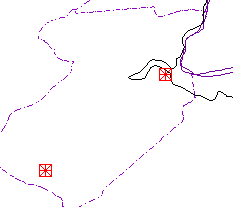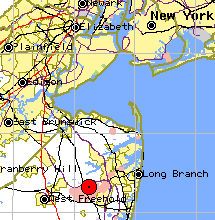 John Laurens Dey was born about 1680 in Staten Island,
New York. He was the son of
Hans Laurentszen Duyts and Sara Hance Vincent Fontaine.
John Dey Sr. died before 8
March 1750/1751 in Perth Amboy, Middlesex County, New Jersey (Machaponix?). He married Anne ****
(Brown?) who was born before 1700 in New York. Her parents are not known. Anne died about Dec 1763 in Middlesex County, New Jersey.
John Laurens Dey was born about 1680 in Staten Island,
New York. He was the son of
Hans Laurentszen Duyts and Sara Hance Vincent Fontaine.
John Dey Sr. died before 8
March 1750/1751 in Perth Amboy, Middlesex County, New Jersey (Machaponix?). He married Anne ****
(Brown?) who was born before 1700 in New York. Her parents are not known. Anne died about Dec 1763 in Middlesex County, New Jersey. [From a letter written by J. Warren Dey in 1902 to E.M. Dye - sent to me by Tom Robertshaw]
-
" On 21st day of Dec. 1725, he purchased from Mindert Johnson of the township of perth amboy
(northern most X on the map to the righ) 200 acres
of land, bounded on the south by Millstone river, and on this tract he settled. This land is located
near Prospect Plains and Cranbury, Middlesex County, New Jersey, (southern most
X on the map to the right) and is now (1902)
owned and occupied by
"Brick House" John Dey a descendant of William Dey of 1718 (son of John Laurens Dey). The
"farm" was approximately 17 miles south of Perth Amboy, New Jersey.
Note that Prospect Plains is just north (less than 3 miles) of Cranbury, New Jersey.
The farm was known as the Old Church Farm and was occupied for at least 125 years by John Dey and his kin."
From Regina Berry: "Will of John Dey; New Jersey Colonial Archives ; will dated 1 October 1750, proved 8 March 1750/1. Names wife Anne ___ (Brown?) and children :
- John Dey married Mary Applegate (there is some disagreement as to the name of John's wife). - born on
Staten Island, New York in 1711 and he died in
Monmouth County, New Jersey in 1772
- Anne Dey was born in 1715 on Staten Island, Nework
and died in 1792 in NJ. Married Lawrence (Laurens) Dey who was born around 1700 in New Jersey and died after 1750 in New Jersey. His mother was Margaret
Dey and his father was James Hance Dey. Anne and Lawrence were effectively first cousins.
He was the son of John Dey's half-brother Jeams Dey. They had 8 children.
A Lawrence Dye (Dey?) served in the New Jersey Militia during the Revolutionary War.
- William Dey was born in 1718 on Staten Island, Richmond County, New York and died in 1784 in Perth Amboy, Middlesex County,
New Jersey. . Married Margaret Salter (her parents are not known). William and Margaret had at least 12 children and William, John, and Kenneth moved to Mason County, Kentucky by ____?
- James Dey - born in 1720 in Staten Island (?), New York, and died in 1764 in New Jersey. Married Sarah Leach. Their son Andrew Dye migrated to Miami County, Ohio around 1770.
- David Dye - born in 1725 in Middlesex County, NJ and died in 1776 in New Jersey. Married Hannah Disbrow. [Sarah Applegate, sister of Mary Applegate had married her cousin Anthony Applegate. His mother was Hannah Disbrow. Was David's wife related?]
- Vincent Dye - born in 1726 in Middlesex, County, New Jersey and died on August 4, 1796 in Prince William County, Virginia. Married Sarah Artepe on September 1, 1746 in Middlesex County, New Jersey. She was born on January 9, 1727 in Somerset, New Jersey and died on October 2, 1797 in Prince William, Virginia. He was Ezekiel Dye's uncle. Prince William Co. VA wills, vol H pg 166 - dated January 6
1796, proved April 4, 1796 - names wife Sarah, three youngest sons: Dusoway, Joseph &
William; other sons: Daniel, John, Vincent, Enoch, Brown, David and Reuben. Five
daughters: Eunice, Rachel, Sarah, Nancy and Caty.
"Vincent and his family moved to Prince William County, Virginia around 1782 as he appears on a tax list for that year." Did he follow his nephew John Dye, son of Johh Dey, who moved to Prince William County around 1776? Vincent Dye appears on the Prince William County, Virginia, Personal Property Tax 1787 - List "A" (Arnold Hovey - 2/10/98). Vincent and Sarah had 14-15 children:
- Joseph Dey - born about 1728 in Middlesex Co., NJ and died in 1805 in NJ. Married (1) Margaret and (2) Martha Wiley.
- K(C)atherine Dye - born in 1730 in Middlesex Co., NJ and died (unmarried?) in 1750 in NJ.
Or, she may have been the Catherine Dye who married the much younger (14 years?) William
Covenhoven.
 John Laurens Dey appears to have moved from Saten Island, New York to Middlesex County, New Jersey (red dot on the map to the right) between 1711 and 1715.
John Laurens Dey appears to have moved from Saten Island, New York to Middlesex County, New Jersey (red dot on the map to the right) between 1711 and 1715.
Will of John Laurens Dye
-
By his will dated Oct. 1, 1750,
proved March 8, 1750 or 51, he names wife Anne, sons John, David, William, James, Vinson [Vincent]
and Joseph, and daughters Anne and Katherine. Executors, my son John, my son William and
my son-in-law, Lawrence Dye (son of James Dey -- Lawrence married Anne, daughter of
John Laurens Dey).
"He devises to his eldest son John, the just sum of five pounds at 8 S. Per ounce to David the just sum of fifty pounds at 8S. Per ounce. To his sons William, James,Vinson, and Joseph, and daughters Anne and Katherine allt (sic) the remainder of the money arising from the sale of my estate to be equally divided amongst them, their heirs, ect. The land was encumbered, the interest on the debt was to be paid by his wife, and to whom, he leaves the use during her life. Also devises to her during life the personalty after payment of debts except therefrom the debt upon the plantation. After the death of his wife, and sale of the property, proceeds to be divided as above set forth. "
Witnesses Peter Perrine (his neighbor), Sten (Steven) Warne, and Sarah Davisson."
It is supposed that his wife survived him many years, as his estate had not yet been settled in Dec. 176(9?). When James Dye mentions in the codical (sic) of his will, the money which is now owing and coming due and payable by virtue of the last will and testament of his father John Dye.
The inference and supposition as to why John was to receive but five pounds, is that he had already given john as his eldest son his full share in other lands, ect..
The desendants of three sons of William are to be found in Mason Co., Kentucky, in different counties of Indiana, Illinois, Missouri, and Texas, also in Oklahoma.
Johns descendants are to be found in Ohio, Illinois and other states.
James' descendants, which have been identified, are to be found in Penn., Ohio, Indiana, and other Western country, but as yet the descendants of but two sons of james have been identified, viz; Andrew and Benjamin, the later being identified within the past year (1904).
At the date of the codicil to will of James Dye, son of John Laurens Dey, all his children were under twenty one years of age. The codicil is dated Dec. 13, 1763. The two claims referring to the share of a deceased son or daughter are identical and as follows:
- I will and ordain that if any of my sons should die before they arrive to the age of 21 years or marry, then the share of the deceased to be divided among the survivors. In case of the
daughters the share is divided among them. James Dye, gives his wife the use of the plantation, three cows, two horses, and some necessary household goods, ect., for the use and benefit of herself and her children to use one year. All his other personalty is ordered sold as soon as practicable and at the end of one year after his death the plantation and personalty preserved are to be sold. This as will be seen could have no other result than a seperation of the family, each to look out for himself and herself. The property or rather proceeds of the sales was to be divided into sixteens, two sixteens to his wife, and each of his sons, and one sixteenth to each of his daughters.
[J. Warren Dey then describes where the various documents noted above could be located.
-
"The conveyence from Vincent Fountain and his mother Sara Hans, with the consent of her husband
Hans Laurens (Duyts corrupted to Dye) to the widow Garretson, is recored in the Clerk's office
in Richmond County, New York, (now the borough of Richmond of the city is greater new York).
The will of vincent Fountain is recorded in the office of the surrogate of the city and
county of New york was made about 1730, and I think proved prior to 1740.
The conveyance from Mindert Johnson to John dey is recorded in the office of the secretary of State, Trenton, New jersey. If in new York, I could give you book and page. The wills of John dey and his son James Dye, will also be found in the office of the secretary of State at Trenton and the original wills are to be found there on file.
You ask the relation of Lawrence Dey to Anne Dye his wife. Anne Dye, as you know was the daughter of John Dey the first of the name to settle in Middlesex county, new jersey. She was the granddaughter of hans Laurenszen and mrs. Sara Fountain Dye. Lawrence Dey was the grandson of the same Hans Laurenszen and his first wife Marritje Sayrs. While in the Lawrence Dey and his wife Anne Dye were own cousins, they were half blood being the grandchild of the same man by different wives."]
The letters of J. Warren Dey are an invaluable insight into not only the Deys and Dyes of Middlesec
County, New Jersey, but the mind of a genealogical researcher as well.
John Dey (son) -- Generation 4